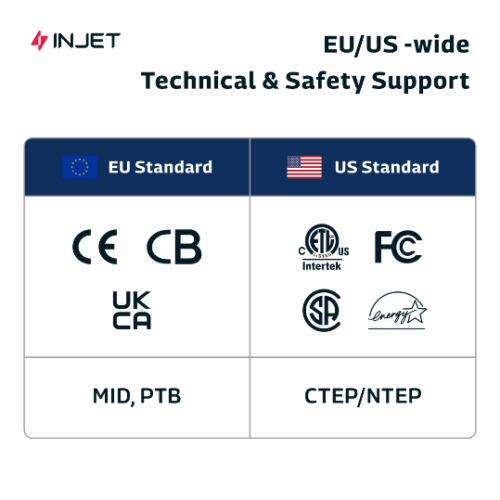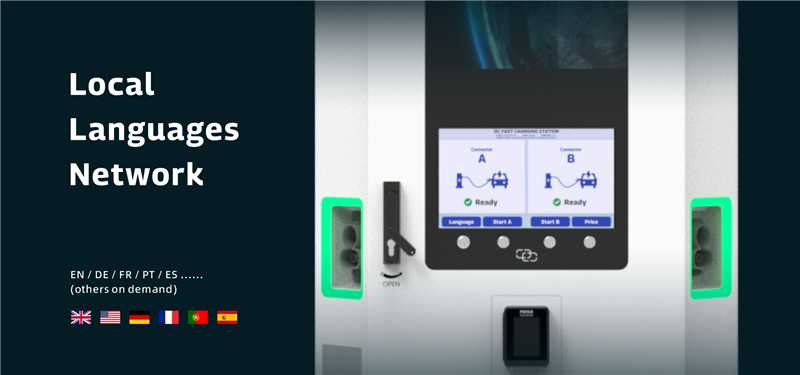As the EV industry accelerates worldwide, charging operators and investors face a core challenge when deploying across regions: certification compliance. Choosing equipment with incomplete certification can undermine your global strategy right from the start. In this article, we explain the strategic value of “full-certified” chargers and use i-Ampax 480 DC Charger as a case study, showing how its certification strength can accelerate your deployment.
1.Client Pain Points: Hidden Costs & Risks of Incomplete Certification
Heightening Market Entry Barriers
Major global markets enforce strict technical regulations. Equipment lacking local certification may be prohibited from sale, unable to connect to the grid, or excluded from subsidies and tenders. For example: In Europe, without CE or RED certification, your goods may be intercepted at customs.
Hidden Costs: Delays and Extra Expenditure
If equipment arrives but is rejected due to certification issues, you may have to send it back for redesign, retesting or part replacement. This not only carries high expense, but delays projects and causes missed market opportunities — the total cost far exceeds the initial savings from selecting a cheaper uncertified unit.
Risk Exposure: Liability & Trust Crisis
Certification is the “trust certificate” for safety and quality. Site owners and insurers often require equipment to hold safety certifications such as ETL. Without certification, you assume safety liability alone, and may damage your brand reputation.
2. Trend Interpretation: Certification Barriers Become Competitive Advantage
Regulations Keep Raising the Bar
Global regulatory standards keep evolving. EU directives continue updating, and North America increasingly values certifications such as Energy Star. Meeting these standards early means locking in market access ahead of competitors.
Certification Complexity Becomes a Barrier
With Europe’s CE, RoHS and RED, and North America’s ETL, FCC, Energy Star, and metering certifications CTEP/NTEP, the complex system itself is a barrier. A “fully certified” device significantly simplifies your procurement and deployment process and becomes an efficiency guarantee.
Certification = Hard Power in Bidding
In government and major enterprise procurement, comprehensive certification is often a “must-have” or a “bonus point”. It is a strong endorsement of brand professionalism and can help you stand out in competition.
3. Decoding Key Certifications: Which “Global Passports” Does Your Charger Need?
To avoid the risks above and build an advantage, your charger should be equipped with the following core certifications:
Europe Market Requirements:
• CE: Mandatory safety passport for devices entering the European Economic Area.
• RoHS: Environmental passport. Restricts use of hazardous substances in products, demonstrating corporate social responsibility.
• RED: Radio Equipment Directive passport. Essential for chargers supporting wireless communication, ensuring electromagnetic compatibility.
North America Market Requirements:
• ETL: Safety certification issued by Intertek, widely recognized in North America; key for insurance and site approval.
• FCC & IC: Electromagnetic compatibility passports. FCC applies to USA, IC to Canada; ensure devices do not interfere with others and operate stably — a must for grid connection.
• Energy Star: Energy-efficiency passport. Indicates lower energy consumption, not only key for subsidy eligibility, but also directly reduces long-term operating costs for operators.
• CTEP/NTEP: Legal metering for commercial operations. This is the legal basis for public charger billing. Without it, your billing operations may not stand on solid legal ground.
4. Solution: The Full Certification Advantage of i-Ampax 480


The i-Ampax 480 DC Charger comes factory-equipped with full certification, offering you a simplified solution:
Certification coverage includes (in the near future) :
- Europe: CE, RoHS, RED
- North America: ETL, FCC, IC, Energy Star, CTEP/NTEP
Customer value creation:
- Faster deployment: No need for repeated certification processes, goods can ship straight to site, significantly shortening project timelines.
- Lower risk: Full coverage of certifications creates a firewall against risk, giving all parties confidence.
- Better operations: CTEP/NTEP ensures compliant billing; Energy Star supports energy-saving and cost reduction.
5. Procurement Action Guide: Four Steps to Smart Purchasing
1) Specify clearly: Ask your supplier to provide a full list of certifications for the target markets.
2) Request proof: Get copies of key certification documents and conformity statements.
3) Evaluate certification completeness: Make it a core evaluation criterion, weighted no less than price and power rating.
4) Prioritise devices like i-Ampax 480 that offer both full certification and upgrade capability.
Conclusion
In an era where global markets shift from expansion to regulation, equipment certification has evolved from a mere “entry requirement” into a “competitive core.” It is not just about installation eligibility — it’s about stable business operations and enduring trust.
Choosing the i-Ampax 480 means opting for an efficient and reliable global pathway. Let our comprehensive certifications safeguard your deployment and help you move ahead confidently in the e-mobility wave.
Contact us now to get full certification details & solution briefing for i-Ampax 480 !





